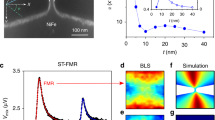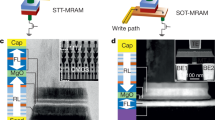Abstract
The successful operation of spin-based data storage devices depends on thermally stable magnetic bits. At the same time, the data-processing speeds required by today’s technology necessitate ultrafast switching in storage devices. Achieving both thermal stability and fast switching requires controlling the effective damping in magnetic nanoparticles. By carrying out a surface chemical analysis, we show that through exposure to ambient oxygen during processing, a nanomagnet can develop an antiferromagnetic sidewall oxide layer that has detrimental effects, which include a reduction in the thermal stability at room temperature and anomalously high magnetic damping at low temperatures. The in situ deposition of a thin Al metal layer, oxidized to completion in air, greatly reduces or eliminates these problems. This implies that the effective damping and the thermal stability of a nanomagnet can be tuned, leading to a variety of potential applications in spintronic devices such as spin-torque oscillators and patterned media.
This is a preview of subscription content, access via your institution
Access options
Subscribe to this journal
Receive 12 print issues and online access
$259.00 per year
only $21.58 per issue
Buy this article
- Purchase on Springer Link
- Instant access to full article PDF
Prices may be subject to local taxes which are calculated during checkout




Similar content being viewed by others
References
Meiklejohn, W. H. & Bean, C. P. New magnetic anisotropy. Phys. Rev. 102, 1413–1414 (1956).
Hagedorn, F. B. Exchange anisotropy in oxidized permalloy thin films at low temperatures. J. Appl. Phys. 38, 3641–3645 (1967).
Patton, C. E. & Wilts, C. H. Temperature dependence of ferromagnetic resonance linewidth in thin Ni–Fe films. J. Appl. Phys. 38, 3537–3540 (1967).
Nogues, J. et al. Exchange bias in nanostructures. Phys. Rep. 422, 65–117 (2005).
Krivorotov, I. N., Leighton, C., Nogues, J., Schuller, I. K. & Dahlberg, E. D. Relation between exchange anisotropy and magnetization reversal asymmetry in Fe/MnF2 bilayers. Phys. Rev. B 65, 100402 (2002).
McMichael, R. D., Stiles, M. D., Chen, P. J. & Egelhoff, W. F. Ferromagnetic resonance studies of NiO-coupled thin films of Ni80Fe20 . Phys. Rev. B 58, 8605–8612 (1998).
Krishnan, K. M. et al. Exchange biasing of permalloy films by MnxPt1−x: Role of composition and microstructure. J. Appl. Phys. 83, 6810–6812 (1998).
Emley, N. C. et al. Time-resolved spin-torque switching and enhanced damping in permalloy/Cu/permalloy spin-valve nanopillars. Phys. Rev. Lett. 96, 247204 (2006).
Fitzsimmons, M. R., Silva, T. J. & Crawford, T. M. Surface oxidation of permalloy thin films. Phys. Rev. B 73, 014420 (2006).
Krivorotov, I. N. et al. Temperature dependence of spin-transfer-induced switching of nanomagnets. Phys. Rev. Lett. 93, 166603 (2004).
Florez, S. H., Katine, J. A., Carey, M., Folks, L. & Terris, B. D. Modification of critical spin torque current induced by rf excitation. J. Appl. Phys. 103, 07A708 (2008).
Kurkijarvi, J. Intrinsic fluctuations in a superconducting ring closed with a Josephson junction. Phys. Rev. B 6, 832–835 (1972).
Myers, E. B. et al. Thermally activated magnetic reversal induced by a spin-polarized current. Phys. Rev. Lett. 89, 196801 (2002).
Sharrock, M. P. Time-dependent magnetic phenomena and particle-size effects in recording media. IEEE Trans. Magn. 26, 193–197 (1990).
Wernsdorfer, W. et al. Experimental evidence of the Neel–Brown model of magnetization reversal. Phys. Rev. Lett. 78, 1791–1794 (1997).
Leighton, C. et al. Coercivity enhancement above the Neel temperature of an antiferromagnet/ferromagnet bilayer. J. Appl. Phys. 92, 1483–1488 (2002).
Fitzsimmons, M. R. et al. Influence of in-plane crystalline quality of an antiferromagnet on perpendicular exchange coupling and exchange bias. Phys. Rev. B. 65, 134436 (2002).
Braganca, P. M. et al. Reducing the critical current for short-pulse spin-transfer switching of nanomagnets. Appl. Phys. Lett. 87, 112507 (2005).
Donahue, M. J. & Porter, D. G. OOMMF User‘s Guide, Version 1.0 Interagency Report NISTIR 6376 (National Institute of Standard and Technology, Gaithersburg, MD, 1999).
Blundell, S. Magnetism in Condensed Matter 188–189 (Oxford Univ. Press, Oxford, 2001).
Gruyters, M. J. Structural and magnetic properties of transition metal oxide/metal bilayers prepared by in situ oxidation. J. Magn. Magn. Mater. 248, 248–257 (2002).
Khapikov, A. F., Harrell, J. W., Fujiwara, H. & Hou, C. Temperature dependence of exchange field and coercivity in polycrystalline NiO/NiFe film with thin antiferromagnetic layer: Role of antiferromagnet grain size distribution. J. Appl. Phys. 87, 4954–4956 (2000).
Sun, J. Z. Spin-current interaction with a monodomain magnetic body: A model study. Phys. Rev. B 62, 570–578 (2000).
Compton, R. L., Pechan, M. J., Maat, S. & Fullerton, E. E. Probing the magnetic transitions in exchange-biased FePt3/Fe bilayers. Phys. Rev. B. 66, 054411 (2002).
Dubowik, D. et al. Temperature dependence of ferromagnetic resonance in permalloy/NiO exchange-biased films. Eur. Phys. J. B 45, 283–288 (2005).
Slonczewski, J. C. Currents and torques in metallic magnetic multilayers. J. Magn. Magn. Mater. 247, 324–338 (2002).
Nadgorny, B. et al. Transport spin-polarization of NixFe1−x: Electron kinematics and band structure. Phys. Rev. B 61, R3788–R3791 (2000).
Fuchs, G. D. et al. Spin-torque ferromagnetic resonance measurements of damping in nanomagnets. Appl. Phys. Lett. 91, 062507 (2007).
Acknowledgements
We thank J. C. Sankey for providing us with the macrospin simulation code and T. Hauet for helpful discussions. This work was supported in part by the Semiconductor Research Corporation, the Office of Naval Research, the NSF/NSEC program through the Cornell Center for Nanoscale Systems and an IBM-Faculty Partnership award. The work was carried out in part at the Cornell NanoScale Facility, a member of the National Nanotechnology Infrastructure Network, which is supported by the National Science Foundation (Grant ECS 03-35765), and it benefited from use of the facilities of the Cornell Center for Materials Research, which is supported by the NSF/MRSEC program.
Author information
Authors and Affiliations
Corresponding author
Supplementary information
Rights and permissions
About this article
Cite this article
Ozatay, O., Gowtham, P., Tan, K. et al. Sidewall oxide effects on spin-torque- and magnetic-field-induced reversal characteristics of thin-film nanomagnets. Nature Mater 7, 567–573 (2008). https://doi.org/10.1038/nmat2204
Received:
Accepted:
Published:
Issue Date:
DOI: https://doi.org/10.1038/nmat2204
This article is cited by
-
Relation between switching time distribution and damping constant in magnetic nanostructure
Scientific Reports (2018)
-
Magnetization switching modes in nanopillar spin valve under the external field
Science China Physics, Mechanics and Astronomy (2011)
-
Interplay between superconductivity and ferromagnetism in crystalline nanowires
Nature Physics (2010)



